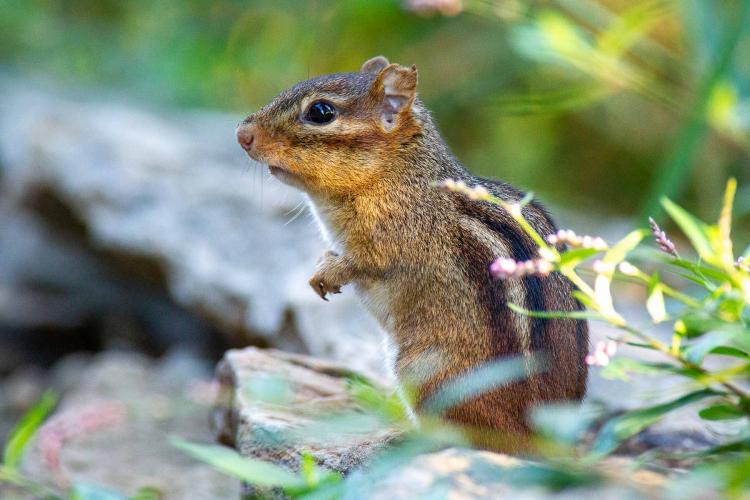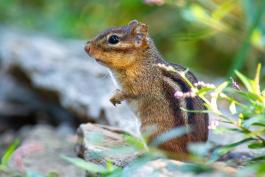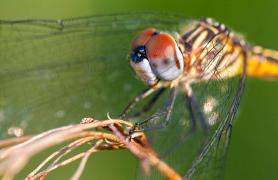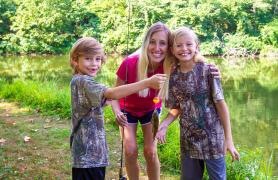Missourians can adapt to living with wildlife, even this black bear. Taking a look at your house or property from the wildlife’s point of view is a great first step in preventing human-wildlife conflicts.
It’s a nice Saturday morning, so you decide to drink your coffee on the back porch. Upon opening the door, you see a dark shadow at the corner of the property line. The neighbor’s dog got out again, you assume. As you start your trek to return Rufus to his owner, the shadow moves into the light. You realize it’s not Rufus. It’s a coyote! You holler at the coyote and scare it away. But what if it comes back?
Every day, Missourians encounter wildlife in one way or another. You might feed songbirds and happily watch them through your kitchen window. Or see a squirrel scampering through your front yard, looking for a good place to cache his latest acorn. Seeing these common species don’t usually cause concern, but what about the more elusive species? What should you do if you see a coyote? A bear? What about a bobcat? Most of the time, just seeing one of these larger species in your yard shouldn’t raise a red flag.
Using some common questions we have received concerning wildlife, we will try to allay your fears and demonstrate that coexisting with wildlife is easier than you might think.
I saw a larger wildlife species in my backyard. Should I be scared?
The answer is usually not at all. As the adage says, wildlife is more scared of you than you are of them. What gets wildlife in trouble is when they lose their fear of humans and that usually begins when they are fed, either intentionally or unintentionally. Bears and raccoons are a great example of this. They are both highly curious and can remember where they got their last easy meal. Once they’ve learned this behavior, it’s difficult to unlearn.
If you see wildlife in your backyard, the main thing to consider is access to food. This could mean making a bird feeder harder to reach or removing it completely. Do you feed your dogs outside? Make sure that food is secure or stored inside. Try and look at your home and property from the viewpoint of wildlife. You may be surprised what you find.
What if a coyote (or other wildlife) isn’t afraid of me? What should I do?
Wildlife, especially in urban areas, have lost their fear of humans. But this isn’t necessarily cause for concern. If you think about the situation from the wildlife’s view, they have no negative interactions with humans. They have human food readily available to feast on, they aren’t being shot at, and they see you every day. Just like you’re not concerned when you see your neighbor pull into their driveway, urban wildlife has accepted you as part of their environment. You are a given to them.
Even if it seems inevitable that some of our wildlife will lose their fear of humans, there are still steps you can take to help. Once again, look around your house and property for food sources. Fence areas, like gardens, to help deter wildlife. Add a hot wire to a fence for added deterrent. You can find helpful information on excluding wildlife around your home on our website at short.mdc.mo.gov/Zho.
How big can coyotes get? And when are they more active?
Coyotes don’t grow as large as other canid (dog) species.
“A big coyote in Missouri is 35 pounds versus a wolf is 120 pounds,” said Josh Wisdom, MDC damage biologist. Keep this size in mind if you know you have coyotes in your area. Keeping domestic dogs leashed and supervising small children will deter a coyote from getting bold.
You will hear coyote calls peak in March during breeding season and during the summer when pups are learning how to hunt. This formative period is a great time to prevent issues into the future. If you see a coyote, scare a coyote. Bang pots and pans, spray them with water, throw sticks, do what you can to give them a negative interaction with humans. For more information, visit short.mdc.mo.gov/ZhJ.
I heard armadillos carry leprosy and bats carry rabies. Is that true?
Yes, both are true. Armadillos naturally have the bacteria that causes Hansen’s disease (leprosy), but according to the Centers for Disease Control and Prevention (CDC), the risk of spreading it to humans is very low. If you have to handle an armadillo, wear gloves.
Most bats don’t have rabies, but it is important to take the necessary precautions just in case. If you know you have bats in your home, determine where the bats are entering and set up a one-way door so they can’t get back in. It is important you don’t set up this exclusion until the fall. Bats breed during the summer and you don’t want pups getting stuck in your attic.
Rabies is transmitted by a bite or through saliva in an open wound. You can’t get rabies from just seeing a bat outside or in your attic. However, the CDC recommends if you wake up to a bat landing on you or find a bat in a room with an unattended child, try to safely capture the bat and have it tested. This is erring on the side of caution since bat teeth are small and sometimes hard to see their bite marks.
By making sure bats don’t roost in your house, you can keep your family safe from bat rabies. Also, never pick up a bat you see on the ground. Bats serve a very important ecological role — they eat lots of insects, especially mosquitoes. You can provide a place for these bats to live by building a bat house for your yard. This way, you get the important benefits of having bats around but keep them out of your house.
A goose was looking at me funny. Will it attack?
Canada geese can be aggressive when humans get close to their nests or goslings. Just like with other wildlife species, if you give them space they will leave you alone. They aren’t just going to charge at you for no reason.
If you have geese in your neighborhood that are a nuisance, there are some steps you can take to make the area less attractive to geese. Create barriers along ponds and lakes to make water access more difficult. This should mean increasing the slope of the pond bank or allowing vegetation to grow thicker on the bank. Also, transition the plant community in the area to ones that are less palatable to the geese. For more information on controlling Canada geese, visit short.mdc.mo.gov/Zqi.
Wildlife species are highly adaptable. That fact makes living next to wildlife an ever-changing adventure. If a technique you’ve been using to happily coexist with wildlife suddenly stops working, try something new. Seeing wildlife in our backyards, even if it’s only a squirrel or a chipmunk, connects us with nature around us. Living with wildlife is something to cherish, not to fear.






















Also In This Issue


And More...
This Issue's Staff
Editor - Angie Daly Morfeld
Associate Editor - Larry Archer
Staff Writer - Bonnie Chasteen
Staff Writer - Heather Feeler
Staff Writer - Kristie Hilgedick
Staff Writer - Joe Jerek
Art Director - Cliff White
Designer - Shawn Carey
Designer - Les Fortenberry
Designer - Marci Porter
Photographer - Noppadol Paothong
Photographer - David Stonner
Circulation - Laura Scheuler






















